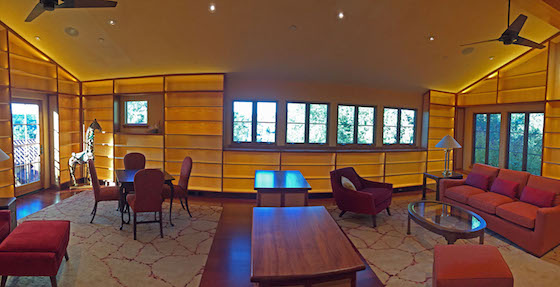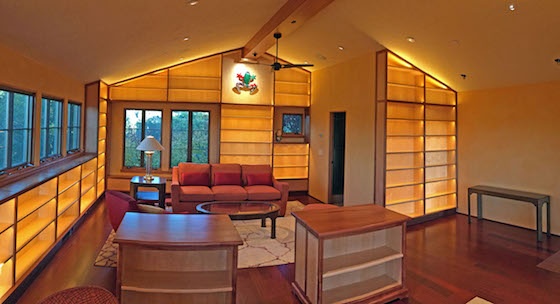Built-In Bookcase Designs

This is a modular built-in bookcase installation made with different hardwoods and special indirect lighting. © 2017 Jay Helms
Built-In Bookcase Design TIPS
- Stop and draw a scale plan 1/2-inch-per-foot scale
- Consider different wood species for eye-popping results
- Build a small prototype - make cases modular
- Incorporate indirect lighting
- CLICK HERE to Get Tim's FREE& FUNNY Newsletter!
DEAR TIM: I live in a 100-year-old wooden house and am doing all the refurbishing and maintenance myself that the laws of my country allow. I’m making floor-to-ceiling built-in bookcases for one of my living rooms and would love some tips. One of my challenges is the bookcase needs to span about 6 feet over a piano. What would you do to support those shelves so there’s no sag from the weight of the books? Any information you can share that would make this project look magnificent and be trouble-free would be appreciated. Harald Skaarn, Tønsberg, Norway
DEAR HARALD: I’ve cut my teeth as a builder / remodeler working on old homes such as yours. I discovered many things during that journey, including that the level of quality, as well as the materials, in these older homes varied to a large degree.
It didn’t take long for me to observe that the pride of workmanship in many of the older homes I worked on was far superior to the level of much of the work I see today. I wonder if it’s the same in your country.
Built-in bookcases are a wonderful project to tackle. I’m assuming you have the needed power tools to make your job easy with respect to cutting and assembling the wood. I’ll also assume you have moderate skills with respect to installation.
CLICK HERE to get FREE & FAST BIDS from local companies that can build custom bookcases.
If you plan out this project carefully, you can build the bookcases in modular sections that interconnect with one another. But when complete, it will appear as if the bookcases were carved out of a solid block of wood or the wall!
STOP - Draw a Plan
You probably already know this, but you need to draw a detailed scale plan of what you want. This plan would show the actual front view of what the finished shelves would look like complete but with no books in them. Think about creating larger areas within the shelves to display art or other things you own that aren’t books but would look fantastic on the shelves.
The plan needs to be larger scale. Draw one section at 1/2-inch per foot to start and see if it has enough detail for you. You want to draw each wall that's going to have bookcases. The plan has to show all the details you can see in your head. If you need to bump up the scale of the plan to 3/4-inch per foot to show what you want, then do it.
Build a Prototype
My first tip may surprise you. I suggest that you start very small. I’d build a prototype small stand-alone bookcase that includes everything you think you want. You’ll want to think about the color of the wood that comprises the sides, back and underside of the shelves. Perhaps you want the bookcases to have two, and maybe three, species of wood for contrast.
CLICK HERE to get FREE & FAST BIDS from local companies that can build custom bookcases.
When you plan to build this prototype, think about how you could make several and butt them against one another to cover an entire wall. It goes without saying that you need to carefully consider the height of the shelves so they’re tall enough for all your books, but not so tall as to waste space. Look at existing bookshelves to determine the sweet spot for the space above the top of books and the bottom of the next shelf above.

This is a side view of the room. These bookcases should give you plenty of inspiration. © 2017 Jay Helms
Indirect Lighting - Add the WOW! Factor
One thing I’d incorporate for sure would be low-voltage indirect lighting to showcase the books and provide softer lighting in the room. You may discover if you use a lighter-colored wood for most of the bookcases that the reflected light provides ample background lighting for the entire room.
The use of low-voltage lighting can help you solve your issue with respect to the wide shelves that have to span over the piano. There are many ways to make those shelves stiff and sag-free, with my choice being to incorporate a small beam under the front edge of the shelf.
Small Beams - Big Strength
This beam would be made from a very stiff hardwood species and be about 40mm (1.5 inches) high. When this piece of wood is glued and mortised into the horizontal shelf, that shelf will be very strong.
At the very least I'd build one prototype shelf and test it with what you expect to put on it. It can just be one shelf supported at each end by wood blocking. You don't need to build an entire case to test how strong one shelf it. See if it deflects after you load it and keep it loaded for a few days.
You’ll discover that this vertical piece of wood is an excellent place to put a thin strip of low-voltage lighting that’s aimed down and towards the back of the shelves. Your biggest challenge I believe, should you decide to incorporate the lighting, will be to get the right balance of light. You don’t want too much and you don’t want the lighting to be weak. Your small prototype shelves will help you solve this problem.

This photo is the other end of the room. I can't begin to describe how magnificent these bookcases are. I hope you enjoy these photos. © 2017 Jay Helms
Be sure you take into consideration how you’ll deal with electrical outlets. I don’t know the codes in your country, but see if you can’t put electrical outlets in the toe kick space down by the floor. You may have existing wall outlets in your walls that might have to be moved so they don’t fall right at the same height as a horizontal shelf.
Add Side Scribes
The odds are the walls to your house are not perfectly plumb or in the same plane. This means that the back of the bookshelves should be designed so their’s an airspace between the wood and the plaster. The vertical sides of your shelves would be made deep enough so they can be scribed to the uneven wall surfaces.
Before you start to draw your plans for this project, I’d take lots of time to look at photographs of built-in bookcases. If you live near a large library or older buildings that might have built-in bookcases, go visit them for inspiration. You may see subtle pieces of trim that create a unique look you had not thought of.
Note how the bookcases terminate at the floor and along walls near a doorway where you might need to have a finished side of a bookcase. Pay close attention to each and every detail including how the shelves are supported.
CLICK HERE to get FREE & FAST BIDS from local companies that can build custom bookcases.
Column 1177
2 Responses to Built-In Bookcase Designs